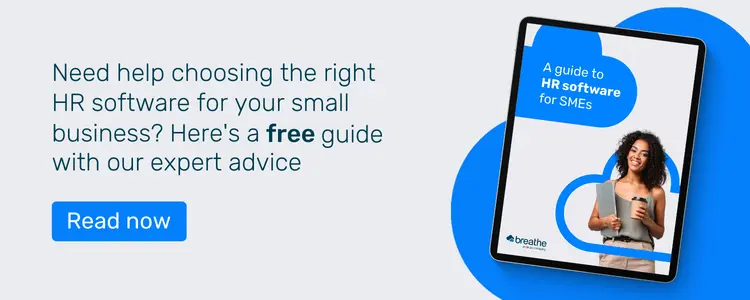From outlining your company mission statement to policies and expectations, an employee handbook makes things clearer for employees and owners alike. Not only that, this handy document can help foster a positive workplace culture and, on occasion, help you out legally.
We know they’re not simple to create. So, to help you make your own, we explain what one is, why it’s important and the key points you should be including.
Jump to:
Why is an employee handbook useful for SMEs?
Is an employee handbook a legal requirement?
Examples of what you should include in an employee handbook
Make HR admin easy with Breathe
What is an employee handbook?
An employee handbook, staff handbook or handbook for employees, is a collection of an employer's policies, practices and procedures in one accessible document.
The handbook acts as an employee manual. It should provide staff with information on how they should communicate issues of harassment, discrimination, absence and other human resource matters. It will also display the company's stance on these issues. In a nutshell, a well-thought-out employee handbook makes it easy to answer any questions an employee may have, including summaries of all company policies.
Alongside this, employee handbooks will inform employees of what is expected of them in terms of their performance and work standards. These standards defined in the employee handbook can then be used when approaching an employee for disciplinary action or dismissal.
With an employee handbook, both the employer and employee will clearly understand their rights and responsibilities.
Why is an employee handbook useful for SMEs?
An employee handbook is an essential for any business. They help a company outline workplace expectations, giving employees a defined structure to work from. This will include guidance on workplace ethics and expected behaviour.
An employee handbook will allow your company to be open about how you respond to harassment, discrimination, favouritism and nepotism in the workplace. In some cases, an employee handbook can help defend the company against employee claims. An employee’s signature on an employee handbook will show that they acknowledge the company's policy and agree to abide by them.
It's a great tool for these serious issues, but also excellent for everyday questions about how the company works. An employee handbook can even save time during employee induction periods, where a lot of information must be discussed. This is particularly useful when showcasing the range of benefits your company offers. it is not always the most important information in an induction but may be useful to have a reference on hand when it comes to accessing health and financial benefits.
In this case, an employee handbook can prevent employers and managers having to relay the same information and lets employees refer to things they may have missed later.
To break it down, the benefits of an employee handbook include:
-
Outline workplace expectations for all employees including workplace ethics, behaviour and performance.
-
Shows what employees can expect from their management.
-
Shows your commitment to addressing and removing harassment and discrimination from your workplace.
-
Showcase the benefits your company can offer.
Is an employee handbook a legal requirement?
Ultimately no, an employee handbook is not a legal requirement for your company. However, you will find that some points you should include in an employee handbook are required by law, such as a health and safety policy or data protection policy.
That aside, when it comes to legal issues, you can use the handbook when you encounter situations such as an employment tribunal. For example, if you are dismissing an employee for discrimination or harassment, you can refer to the employee handbook and the employee performance standards set within. If the employee has signed off on these in agreement, these standards can be used legally.
Alongside this, if you include elements or expand upon anything found in the employee contract in the handbook, this will be deemed as part of the contract, and is legally binding.
If you include anything to do with employment law in your own employee handbook, it is best to build a ‘flexibility clause’ into the handbook. This will give you the right to re-work or amend the handbook when employment law changes.
 What should be covered in a staff handbook?
What should be covered in a staff handbook?
If you haven’t already created one, you should be considering what to include in your own employee handbook. If you’re stuck, we’ve identified the following essential elements for you to include:
Examples of what to include in an employee handbook:
Health and safety policy
You should include your health and safety policy as part of your employee handbook. The policy is required by law if you have a business of five or more employees. Including it in your handbook will be useful as a reference to ensure all employees are aware.
A health and safety policy will include information on who their health and safety reps are, risk assessments and the health and safety equipment.
Equal opportunities policy
If you don’t already have one of these, we highly recommend you create one. They are a great way to demonstrate how you are committed to tackling indirect and direct discrimination in the workplace.
Including one of these as part of an employee handbook will help employees know what is deemed unacceptable behaviour in relation to equal opportunities.
Harassment policy
Discrimination and harassment are both things that we should never tolerate in a workplace. Your employee handbook should outline that this is the case and should clearly explain that it is a disciplinary offence. Your harassment policy should clearly state what is expected of employees in regard to their behaviour.
Grievance procedure
An important item to include alongside your equal opportunities and harassment policies is your grievances procedure. This will explain to your employees how they can raise a grievance and how you as an employer should respond.
This is an important process in tackling harassment and discrimination. You will want to create an environment where raising a grievance about these issues is as seamless as possible.
A dismissal and disciplinary procedure
You should include your disciplinary procedure as part of the employee handbook. On its own, it should be sent to employees within two months of starting employment. So, including it as part of the handbook makes a lot of sense.
This should include details of all the disciplinary rules, including giving disciplinary warnings, disciplinary meetings, appeals and what constitutes gross misconduct.
Data protection policy
A system to ensure safe storage and processing of employee data is a legal requirement. As a company you should already have one, and by including it in your employee handbook you will provide a reference to employees who are seeking that information.
Your data protection policy should include information on the principles of data protection and how your employees should follow them, how you process staff data and the handling of sensitive data.
What else should an employee handbook contain?
On top of those we’ve mentioned, there are a number of other elements that you should be aware of. While these do not have to be in the handbook, it’s worth including them to make sure you and your employees have all the information they need in one place.
For example, you should also consider the following additions::
-
Maternity, paternity and parental leave information
-
Flexible working practices
-
Staff internet policy
-
Alcohol and drugs policy
-
Sickness policy
-
The redundancy process
Make HR admin easy with Breathe
Make losing documents a thing of the past. With Breathe's HR software all your company's important files are securely stored in one instantly accessible place.
Easily store HR documents, share them with your team & access them from anywhere to streamline your HR admin. You’ll never lose a document again—and nor will your employees.
Start your free 14-day trial today to start transforming your HR process.
Author: Andy Stewart





